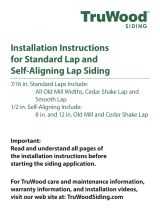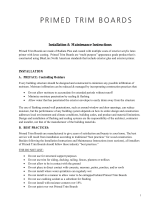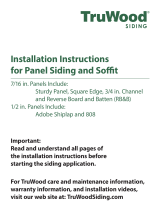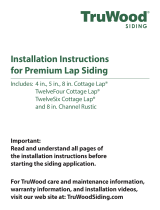Page is loading ...

HS1236 - P1/3 1/13
GENERAL REQUIREMENTS:
INSTALLATION:
Fastener Requirements
Position fasteners 3/8" from panel edges and no closer than
2" away from corners. Do not nail into corners.
HardiePanel Vertical Siding Installation
• Framing must be provided at horizontal and vertical edges for nailing.
• HardiePanel vertical siding must be joined on stud.
• Double stud may be required to maintain minimum edge
nailing distances.
Figure 2
Caulk Joint
leave appropriate gap between
panels, then caulk*
water-resistive barrier
2 x 4 stud
“H” Joint
water-resistive barrier
2 x 4 stud
Batten Joint
water-resistive barrier
2 x 4 stud
SMOOTH CEDARMILL
©
SELECT SIERRA 8 STUCCO
Figure 1
James Hardie
®
products contain respirable crystalline silica, which is known to the State of California to cause cancer and is considered by IARC and NIOSH to be a cause of cancer from some occupational sources. Breathing
excessive amounts of respirable silica dust can also cause a disabling and potentially fatal lung disease called silicosis, and has been linked with other diseases. Some studies suggest smoking may increase these risks. During
installation or handling: (1) work in outdoor areas with ample ventilation; (2) use fiber cement shears for cutting or, where not feasible, use a HardieBlade
®
saw blade and dust-reducing circular saw attached to a HEPA vacuum;
(3) warn others in the immediate area; (4) wear a properly-fitted, NIOSH-approved dust mask or respirator (e.g. N-95) in accordance with applicable government regulations and manufacturer instructions to further limit
respirable silica exposures. During clean-up, use HEPA vacuums or wet cleanup methods - never dry sweep. For further information, refer to our installation instructions and Material Safety Data Sheet available at
www.jameshardie.com or by calling 1-800-9HARDIE (1-800-942-7343). FAILURE TO ADHERE TO OUR WARNINGS, MSDS, AND INSTALLATION INSTRUCTIONS MAY LEAD TO SERIOUS PERSONAL INJURY OR DEATH.
SD050905
• These instructions to be used for residential single family installations only. For Commercial / Multi-Family installation requirements go to www.JamesHardieCommercial.com
• HardiePanel
®
vertical siding can be installed over braced wood or steel studs spaced a maximum of 24" o.c. See genernal fastening requirements. Irregularities in
framing and sheathing can mirror through the finished application. James Hardie recommends installing HardiePanel on a capillary break (rainscreen/furring) as a best practice.
• Information on installing James Hardie products over foam can be located in JH Tech Bulletin 19 at www. jamehardie.com
• A water-resistive barrier is required in accordance with local building code requirements. The water-resistive barrier must be appropriately installed with
penetration and junction flashing in accordance with local building code requirements. James Hardie will assume no responsibility for water infiltration. James
Hardie does manufacture HardieWrap
®
Weather Barrier, a non-woven non-perforated housewrap1, which complies with building code requirements.
• When installing James Hardie products all clearance details in figs. 5,6,7,8,9,10&11 must be followed.
• Adjacent finished grade must slope away from the building in accordance with local building codes - typically a minimum of 6" in the first 10'.
• Do not install James Hardie products, such that they may remain in contact with standing water.
• HardiePanel vertical siding may be installed on vertical wall applications only.
• DO NOT use HardiePanel vertical siding in Fascia or Trim applications.
• Some application are not suitable for ColorPlus. Refer to ColorPlus section page 3.
• DO NOT use stain, oil/alkyd base paint, or powder coating on James Hardie
®
Products.
• For larger projects, including commercial and multi-family projects, where the span of the wall is significant in length, the designer and/or architect should take
into consideration the coefficient of thermal expansion and moisture movement of the product in their design. These values can be found in the Technical Bulletin
#8 “Expansion Characteristics” at www.JamesHardie.com.
Figure 4
Recommendation: When
installing Sierra 8, provide
a double stud at panel
joints to avoid nailing
through grooves.
Figure 3
moderate contact
keep fasteners 2"
away from corners
plate
keep nails
3/8" min.
from panel
edges
water-resistive
barrier
stud
HardiePanel
vertical siding
3/8"
sheathing
upper panel
1/4" gap
Z-flashing
Do not
Caulk
lower
panel
upper panel
1/4" gap
Z-flashing
Do not
Caulk
lower
panel
decorative
band board
water-resistive
barrier
water-resistive
barrier
(Not applicable to ColorPlus
®
Finish)
*Apply caulk in accordance with caulk
manufacturer’s written application instructions.
Joint Treatment
• Vertical Joints - Install panels in moderate contact (fig. 1), alternatively
joints may also be covered with battens, PVC or metal jointers or
caulked (Not applicable to ColorPlus
®
Finish) (fig. 2).
• Horizontal Joints - Provide Z-flashing at all horizontal joints (fig. 3).
1
For additional information on HardieWrap™ Weather Barrier, consult James Hardie at 1-866-4Hardie or www.hardiewrap.com
INSTALLATION REQUIREMENTS RESIDENTIAL SINGLE FAMILY ONLY - PRIMED & COLORPLUS
®
PRODUCTS
Visit www.jameshardie.com for the most recent version.
Vertical Siding
EFFECTIVE SEPTEMBER 2013
OUTDOORS
1. Position cutting station so that wind will blow dust away from user
and others in working area.
2. Use one of the following methods:
a. Best: i. Score and snap
ii. Shears (manual, electric or pneumatic)
b. Better: i. Dust reducing circular saw equipped with a
HardieBlade
®
saw blade and HEPA vacuum extraction
c. Good: i. Dust reducing circular saw with a HardieBlade saw blade
(only use for low to moderate cutting)
INDOORS
1. Cut only using score and snap, or shears (manual, electric or pneumatic).
2. Position cutting station in well-ventilated area
- NEVER use a power saw indoors
- NEVER use a circular saw blade that does not carry the HardieBlade saw blade trademark
- NEVER dry sweep – Use wet suppression or HEPA Vacuum
Important Note: For maximum protection (lowest respirable dust production), James Hardie recommends always using “Best”-level cutting methods where feasible.
NIOSH-approved respirators can be used in conjunction with above cutting practices to further reduce dust exposures. Additional exposure information is available
at www.jameshardie.com to help you determine the most appropriate cutting method for your job requirements. If concern still exists about exposure levels or you
do not comply with the above practices, you should always consult a qualified industrial hygienist or contact James Hardie for further information.
SD083105
CUTTING INSTRUCTIONS
STORAGE & HANDLING:
IMPORTANT: FAILURE TO INSTALL AND FINISH THIS PRODUCT IN ACCORDANCE WITH APPLICABLE BUILDING CODES AND JAMES HARDIE
WRITTEN APPLICATION INSTRUCTIONS MAY LEAD TO PERSONAL INJURY, AFFECT SYSTEM PERFORMANCE, VIOLATE LOCAL BUILDING CODES,
AND VOID THE PRODUCT ONLY WARRANTY. BEFORE INSTALLATION, CONFIRM THAT YOU ARE USING THE CORRECT HARDIEZONE INSTRUCTIONS.
INSTALLATION OF HZ10™ PRODUCTS OUTSIDE AN HZ10
®
LOCATION WILL VOID YOUR WARRANTY. TO DETERMINE WHICH HARDIEZONE APPLIES
TO YOUR LOCATION, VISIT WWW.HARDIEZONE.COM OR CALL 1-866-942-7343 (866 9HARDIE)
Store flat and keep dry and
covered prior to installation. Installing
siding wet or saturated may result in
shrinkage at butt joints. Carry planks
on edge. Protect edges and corners
from breakage. James Hardie is not
responsible for damage caused
by improper storage and handling of
the product.

HS1236 - P2/3 8/13
Figure 5
Figure 7
Figure 10
Figure 6
joist
1" - 2" min.
water
resistive
barrier
siding
flashing
deck material
ledger
Figure 8
1"- 2" min.
6" min.
bottom
plate
siding
stud
concrete
foundation
1" - 2" min.
Figure 9
CLEARANCES
Install siding and trim products in
compliance with local building code
requirements for clearance between
the bottom edge of the siding and
the adjacent finished grade.
Maintain a minimum 1"
- 2" clearance between
James Hardie
®
products and paths,
steps and driveways.
Maintain a minimum 1" - 2" clearance
between James Hardie products
and decking material.
At the juncture of the roof and vertical
surfaces, flashing and counterflashing
shall be installed per the roofing
manufacturer’s instructions. Provide a
minimum 1"- 2" clearance between
the roofing and the bottom edge of the
siding and trim.
Maintain a minimum 1" gap
between gutter end caps and
siding & trim.
fascia
siding
1"
gutter and end cap
Framing
Flooring
Horizontal
Trim
Water-
Resistive
Barrier
Sheathing
R
HardiePanel
Do not bridge floors with HardiePanel
®
siding. Horizontal
joints should always be created between floors (fig. 10).
Maintain a 1/4"
clearance between
the bottom of James
Hardie products and
horizontal flashing.
Do not caulk gap.
Refer to fig. 3 on
page 1.
Figure 11
Self-adhering
membrane
Step flashing
Housewrap
Drip edge
Kickout
flashing
Self-adhering
eaves membrane
KICKOUT FLASHING
Because of the volume of water that can pour down a sloped
roof, one of the most critical flashing details occurs where a
roof intersects a sidewall. The roof must be flashed with step
flashing. Where the roof terminates, install a kickout to deflect
water away from the siding. It is best to install a self-adhering
membrane on the wall before the subfascia and trim boards
are nailed in place, and then come back to install the kickout.
Figure 11, Kickout Flashing To prevent water from
dumping behind the siding and the end of the roof
intersection, install a "kickout" as required by IRC code
R905.2.8.3 : “…flashing shall be a min. of 4” high and 4”
wide.” James Hardierecommends the kickout be angled
between 100° - 110° to maximize water deflection
GENERAL FASTENING REQUIREMENTS
Fasteners must be corrosion resistant, galvanized, or stainless steel. Electro-galvanized are
acceptable but may exhibit premature corrosion. James Hardie recommends the use of quality,
hot-dipped galvanized nails. James Hardie is not responsible for the corrosion resistance of
fasteners. Stainless steel fasteners are recommended when installing James Hardie products near
the ocean, large bodies of water, or in very humid climates.
• Consult applicable product evaluation or listing for correct fastener type and placement to achieve
specific design wind loads.
• NOTE: Published wind loads may not be applicable to all areas where Local Building Codes have
specific jurisdiction. Consult James Hardie Technical Services if you are unsure of applicable
compliance documentation.
• Drive fasteners perpendicular to siding and framing.
• Fastener heads should fit snug against siding (no air space). (fig. A)
• Do not over-drive nail heads or drive nails at an angle.
• If nail is countersunk, fill nail hole and add a nail. (fig. B)
• For wood framing, under driven nails should be hit flush to the plank with a hammer (for steel
framing, remove and replace nail).
• NOTE: Whenever a structural member is present, HardiePlank should be fastened with even
spacing to the structural member. The tables allowing direct to OSB orplywood should only be
used when traditional framing is not available.
• Do not use aluminum fasteners, staples, or clipped head nails.
Figure A
Figure B
Countersunk,
ll & add nail
PNEUMATIC FASTENING
James Hardie products can be hand nailed or fastened with a
pneumatic tool. Pneumatic fastening is highly recommended.
Set air pressure so that the fastener is driven snug with the
surface of the siding. A flush mount attachment on the
pneumatic tool is recommended. This will help control the
depth the nail is driven. If setting the nail depth proves difficult,
choose a setting that under drives the nail. (Drive under driven
nails snug with a smooth faced hammer - Does not apply for
installation to steel framing).
BLOCKED PENETRATIONS
Penetrations such as hose bibs and holes 1 ½” or larger such as dryer vents
should have a block of trim around point of penetration.

HS1236 - P3/3 6/13
COLORPLUS
®
TECHNOLOGY CAULKING, TOUCH-UP & LAMINATE
• Care should be taken when handling and cutting James Hardie® ColorPlus® products. During installation use a wet soft cloth or soft brush to
gently wipe off any residue or construction dust left on the product, then rinse with a garden hose.
• Touch up nicks, scrapes and nail heads using the ColorPlus
®
Technology touch-up applicator. Touch-up should be used sparingly.
If large areas require touch-up, replace the damaged area with new HardiePanel
®
siding with ColorPlus Technology.
• Laminate sheet must be removed immediately after installation of each course.
• Terminate non-factory cut edges into trim where possible, and caulk. Color matched caulks are available from your ColorPlus
®
product dealer.
• Treat all other non-factory cut edges using the ColorPlus Technology edge coaters, available from your ColorPlus product dealer.
Note: James Hardie does not warrant the usage of third party touch-up or paints used as touch-up on James Hardie ColorPlus products.
Problems with appearance or performance arising from use of third party touch-up paints or paints used as touch-up that are not James Hardie
touch-up, will not be covered under the James Hardie ColorPlus Limited Finish Warranty.
The following outlines the recommended applications for ColorPlus and Primed panels. Not all designs will be suitable for
every application:
• Exposed fasteners or battens is the recommended application for ColorPlus panel products
• Do not use touch-up over fastener heads for smooth ColorPlus products - primed panel recommended
• For ColorPlus panel applications that require fasteners in the field, it is acceptable to use touch-up over fasteners for Cedarmill and Stucco panel
only, but correct touch-up application is important. Some colors may show touch-up when applied over fasteners. Trim is recommended to cover
joints when appropriate.
PAINTING JAMES HARDIE
®
SIDING AND TRIM PRODUCTS WITH COLORPLUS
®
TECHNOLOGY
When repainting ColorPlus products, James Hardie recommends the following regarding surface preparation and topcoat application:
• Ensure the surface is clean, dry, and free of any dust, dirt, or mildew
• Repriming is normally not necessary
• 100% acrylic topcoats are recommended
• DO NOT use stain, oil/alkyd base paint, or powder coating on James Hardie
®
Products
• Apply finish coat in accordance with paint manufacturers written instructions regarding coverage, application methods, and application
temperature
© 2013 James Hardie Building Products. All rights reserved.
TM, SM, and ® denote trademarks or registered trademarks of
James HardieTechnology Limited is a registered
trademark of James Hardie Technology Limited.
RECOGNITION: In accordance with ICC-ES Evaluation Report ESR-1844, HardiePanel® vertical siding is recognized as a suitable alternate to that specified in: the 2006.2009, & 2012 International Residential Code for One-and
Two-Family Dwellings and the 2006, 2009, & 2012 International Building Code. HardiePanel vertical siding is also recognized for application in the following: City of Los Angeles Research Report No. 24862, State of Florida
listing FL#889, Dade County, Florida NOA No. 02-0729.02, U.S. Dept. of HUD Materials Release 1263c, Texas Department of Insurance Product Evaluation EC-23, City of New York MEA 223-93-M, and California DSA PA-019.
These documents should also be consulted for additional information concerning the suitability of this product for specific applications.
Additional Installation Information,
Warranties, and Warnings are available at
www.jameshardie.com
CUT EDGE TREATMENT
Caulk, paint or prime all field cut edges.
James Hardie touch-up kits are required
to touch-up ColorPlus products.
CAULKING
For best results use an Elastomeric Joint Sealant complying with ASTM C920 Grade NS, Class 25 or higher or a Latex Joint Sealant complying with ASTM C834.
Caulking/Sealant must be applied in accordance with the caulking/sealant manufacturer’s written instructions. Note: OSI Quad as well as some other caulking
manufacturers do not allow tooling.
DO NOT caulk nail heads when using ColorPlus products, refer to the ColorPlus touch-up section
PAINTING
DO NOT use stain, oil/alkyd base paint, or powder coating on James Hardie
®
Products. James Hardie products
must be painted within 180 days for primed product and 90 days for unprimed. 100% acrylic topcoats are
recommended. Do not paint when wet. For application rates refer to paint manufacturers specifications.
Back-rolling is recommended if the siding is sprayed.

HS1253-P3/3 8/13
MASILLA, RETOQUES Y LAMINADO CON COLORPLUS
®
TECHNOLOGY
• Se debe tener cuidado al manipular y cortar los productos ColorPlus de James Hardie. Durante la instalación, utilice un paño suave y húmedo, o un
cepillo suave para quitar con delicadeza cualquier residuo o polvo de construcción que haya quedado en el producto. Luego, enjuague con una
manguera de jardín.
• Retoque las muescas, arañazos y cabezales de los clavos usando el aplicador de retoques ColorPlus
®
Technology. La pintura de retoques debería usarse con
moderación. Si las zonas que requieren retoques son grandes, sustituya el área dañada con un bordo nuevo HardiePlank
®
con ColorPlus Technology.
• La hoja laminada debe quitarse de inmediato tras la instalación de cada capa.
• Termine los bordes de corte que no son de fábrica en acabados, siempre que sea posible, y añada masilla. Existen masillas con colores a juego en su proveedor de
productos ColorPlus.
• Trate todos los bordes de corte que no son de fábrica usando revestimientos de bordes de tecnología ColorPlus, disponibles en su proveedor de
productos ColorPlus.
Nota: James Hardie no garantiza el uso de productos para retoque o pintura de terceros que se usen para retocar productos ColorPlus de James Hardie.
La garantía limitada y finalizada para ColorPlus de James Hardie no cubrirá los problemas relacionados con la apariencia o el rendimiento que provengan de las
pinturas para retoque de terceros o pinturas que se usen para retocar que no sean James Hardie.
A continuación se describen las aplicaciones recomendadas para ColorPlus y paneles de cebada. No todos los diseños serán adecuados para el
cada aplicación:
• Los sujetadores o listones expuestos son la aplicación recomendada para los productos ColorPlus Panel.
• No utilice retoque sobre las cabezas de acoplamiento para los productos ColorPlus lisas - Panel imprimado recomendado
• Para aplicaciones de panel ColorPlus que requieren sujetadores en el campo, es aceptable el uso de retoque sobre el anclaje para Cedarmill y el
panel de estuco solamente, pero la aplicación de retoque correcta es importante. Algunos colores pueden mostrar retocar cuando se aplica sobre
los sujetadores. Se recomienda ajuste para cubrir las articulaciones al siguiente appropriate.he describe las aplicaciones recomendadas para
ColorPlus y paneles de cebada.
PINTAR PRODUCTOS DE JAMES HARDIE
®
CON COLORPLUS
®
TECHNOLOGY
Cuando vuelva a pintar productos ColorPlus, James Hardie recomienda usar lo siguiente para la preparación de superficies y aplicación de recubrimientos finales:
• Asegúrese de que la superficie está limpia, seca y libre de polvo, suciedad o moho.
• Normalmente no es necesario volver a aplicar imprimación
• Se recomienda usar recubrimientos finales 100% acrílicos.
• NO utilice tintes, pinturas a base de aceite, resina alquídica o polvos recubridores en los productos James Hardie
®
.
• Aplique una capa de acabado de acuerdo con las instrucciones del fabricante en cuando a cobertura, métodos de aplicación y temperatura de aplicación.
• NO aplique masilla en los cabezales de los clavos cuando utilice productos ColorPlus; consulte la sección de retoques de ColorPlus.
© 2013 James Hardie Building Products. Todos los derechos
reservados. TM, SM y ® denotan marcas comerciales o marcas
comerciales registradas de James Hardie Technology Limited.
RECONOCIMIENTO: De acuerdo con el Informe de Evaluación ICC-ES ESR-1844, los revestimientos verticales HardiePanel® se reconocen como una alternativa adecuada para aquello que se especifica en: el Código residencial
internacional de vivienda para una o dos familias de 2006, 2009 y 2012, y en el Código internacional de construcción de 2006, 2009 y 2012. Los revestimientos verticales HardiePanel también son reconocidos por su aplicación
en lo que se detalla a continuación: Informe de investigación de la Ciudad de Los Ángeles N.º 24862, lista del estado de Florida FL#889, Condado de Dade, Florida NOA N.º 02-0729.02, comunicado sobre materiales 1263 del
Departamento de Vivienda y Desarrollo Urbano de los Estados Unidos, Departamento de Texas de evaluación del seguro del producto EC-23, ciudad de Nueva York MEA 223-93-M, y California DSA PA-019. Estos documentos
también deben ser consultados para obtener información adicional respecto de la pertinencia de este producto para aplicaciones específicas.
La información de instalación adicional,
garantías y avisos están
disponibles en www.jameshardie.com
TRATAMIENTO DE LOS BORDES
DEL CORTE
Añada masilla, pinte o aplique imprimación a
todos los bordes de los lados cortados. Se
requieren los kits de retoque de James Hardie
para retocar los productos ColorPlus.
AÑADIR MASILLA
Para obtener mejores resultados utilice sellador de juntas elastomérico ASTM C920 Grado NS Clase 25 o superior, o un sellador de juntas de látex de
conformidad con ASTM C834. La masilla/sellador debe aplicarse de acuerdo con las instrucciones por escrito del fabricante de la masilla/sellador.
Nota: OSI Quad así como algunos otros fabricantes de masilla NO permiten herramientas.
No selle cabezas de los clavos cuando utilice productos ColorPlus, consulte la sección de retoque ColorPlus
PINTURA
NO utilice tintes, pinturas a base de aceite, resina alquídica o polvos recubridores en los productos James
Hardie
®
. Los productos de James Hardie deben pintarse en un plazo de 180 días para los productos con
imprimación y 90 días para los productos sin imprimación. Se recomienda usar recubrimientos finales
100% acrílicos. No pintar si está húmedo. Consulte las tasas de aplicación en las especificaciones del
fabricante de pinturas. Se recomienda repasar con un rodillo si se ha pintado el revestimiento con spray.
/







